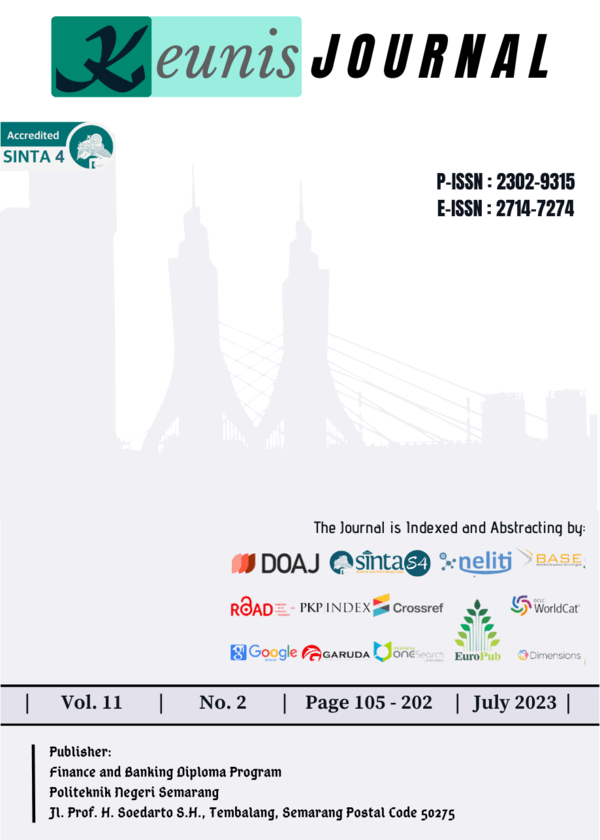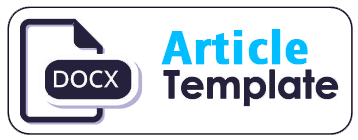INTERNAL AUDIT MODEL POST-ERP IMPLEMENTATION (ENTERPRISE RESOURCE PLANNING) AT PT XYZ
DOI:
https://doi.org/10.32497/keunis.v11i2.4358Keywords:
Monitor, Evaluate, and Assess (MEA), Enterprise Resource Planning (ERP), COBIT 2019Abstract
The research aims to compare the audit process carried out after ERP implementation with the audit model using the 2019 COBIT framework in the Monitor, Evaluate and Assess domain. It is evaluating the effectiveness of the audit using COBIT 2019 compared to the audit currently being conducted at PT XYZ. This research is applied research, using a case study method and a qualitative approach. The object of this research is PT XYZ, a company distributing pipe and pump products. 2017 PT XYZ implemented an ERP system to replace the previous program. Data analysis with the steps applied compared to the current audit process carried out at PT XYZ with the 2019 COBIT-based audit using the Monitor, Evaluate, and Assess (MEA) approach and evaluated the effectiveness of the audit model using COBIT 2019, which can ensure that audit objectives in the ERP system can be achieved effectively. The result of the research shows that there are differences in the audit process that PT has carried out. XYZ after implementing ERP with an audit model using the COBIT 2019 framework. This difference can be affected by the time of system implementation. The audits using COBIT 2019 can be considered very effective compared to the previous audits conducted by PT XYZ. By using COBIT 2019, it can help PT XYZ in designing governance using several design factors that have been provided.References
Adikara, Fransiskus. (2013). Implementasi Tata Kelola Teknologi Informasi Perguruan Tinggi Berdasarkan Cobit 5 Pada Laboratorium Rekayasa Perangkat Lunak Universitas Esa Unggul. Seminar Nasional Sistem Informasi Indonesia, 2 -4 Desember 2013
Al-rasyid, A. (2015). Analisis Audit Sistem Informasi Berbasis COBIT 5 Pada Domain Deliver , Service , and Support ( DSS ) ( Studi Kasus : SIM-BL di Unit CDC PT Telkom Pusat . Tbk ). E-Proceeding of Engineering, 2(2), 6110”“6123.
Alvin A. Arens, Randal J. Elder, M. S. B. (2014). AUDITING DAN JASA ASSURANCE (S. Saat (ed.); 15th ed.). PENERBIT ERLANGGA.
Anastasia, P. N., Atrinawati, L. H., Studi, P., Informasi, S., & Kalimantan, I. T. (2020). Perancangan Tata Kelola Teknologi Informasi Menggunakan Framework Cobit 2019 Pada Hotel Xyz. Jurnal Sistem Informasi (E-Journal), 12(2).
Dechow, N., & Mouritsen, J. (2005). Enterprise resource planning systems, management control and the quest for integration. Accounting, Organizations and Society, 30(7”“8), 691”“733.
https://doi.org/10.1016/j.aos.2004.11.004
Fransiskus, A. (2013). Implementasi Tata Kelola Teknologi Informasi Perguruan Tinggi Berdasarkan Cobit 5 Pada Laboratorium Rekayasa Perangkat Lunak. Seminar Nasional Sistem Informasi Indonesia, 2, 2”“4.
Gunawan, R., & Tjahjadi, D. (2021). Audit Sistem Informasi Akademik Berbasis Web Menggunakan Framework COBIT 5.0 Pada Domain APO13 dan DSS05 (Studi Kasus: SIAT STMIK ROSMA Karawang). Jurnal Interkom: Jurnal Publikasi Ilmiah Bidang Teknologi Informasi Dan Komunikasi, 13(3), 29”“40. https://doi.org/10.35969/interkom.v13i3.53
Hardinata, Rio Septian et al. (2019). Audit Tata Kelola Teknologi Informasi Menggunakan COBIT 5 (Studi Kasus : Universitas Pembangunan Panca Budi Medan). JURNAL TEKNIK DAN INFORMATIKA VOLUME 6 | NOMOR 1 | JANUARI 2019
Herianto & Wasilah. (2022). Assessment Capability Level dan Maturity Level Tata Kelola TI pada Kantor Kementerian Agama Kabupaten Pesawaran Provinsi Lampung Menggunakan Framework COBIT 2019. Konstelasi : Konvergensi Teknologi Dan Sistem Informasi, 2(2), 229”“240.
Ifinedo, Princely Emili. (2006). Enterprise Resource Planning Systems Success Assessment: An Integrative Framework. Jyväskylä : University of Jyväskylä
Indrajit, R. E. (2016). Tata Kelola Teknologi Informasi.
https://www.academia.edu/30100457/Tata_Kelola_Teknologi_Informasi
ISACA. (2018). Governance and Management Objectives. In COBIT ® 2019 Framework. https://www.isaca.org/resources/cobit
Madani, H. H. (2000). Re-engineering the role of the internal auditor in ERP solutions. Challenges of Information Technology Management in the 21St Century, 103”“105.
Margen, Mohd Rhedo. (2014). Penerapan ERP Modul Payroll Menggunakan Open ERP Dengan Metode Sure Step (Studi Kasus : PT XYZ Retail Fashion).
Maulana, A. (2021). Kajian Perbandingan COBIT 5 Dengan COBIT 2019 Sebagai Framework Audit Tata Kelola Teknologi Informasi. Jurnal Ilmiah Indonesia p”“ISSN: 2541-0849 e-ISSN: 2548-1398, 6(1), 30”“39.
Mohamad, A. A., R, M. D., & Ali, M. (2019). Perbandingan Cobit 2019 Dan Itil V4 Sebagai Panduan Tata Kelola Dan Management It. Jurnal Computech & Bisnis, 13(2), 100”“105.
Putra, Yogie. (2019). Audit Sistem Informasi dan Penggunaannya. Diakses dari :
http://spi.upi.edu/2019/09/24/audit-sistem-informasi-dan-penggunaannya/
Rainer, K.R., Prince, B., & Cegielski., C.G. (2015). Introduction to Information Systems, Fifth Edition. Diakses dari : http://docshare01.docshare.tips/files/31709/317098453.pdf
Rio Hardinata, Wirda Fitriani, Cahyo Pramono, Muhammad Muttaqin, Husni Muharam Ritonga, Leni Marlina, Suheri, A. K. (2019). Audit Tata Kelola Teknologi Informasi menggunakan Cobit 5 (Studi Kasus : Universitas Pembangunan Panca Budi Medan). Jurnal Tehnik Dan Informatika, 6, 43”“45.
Saleh, M., Yusuf, I., & Sujaini, H. (2021). Penerapan Framework COBIT 2019 pada Audit Teknologi Informasi di Politeknik Sambas. Jurnal Edukasi Dan Penelitian Informatika (JEPIN), 7(2), 204. https://doi.org/10.26418/jp.v7i2.48228
Sulaeman, F. S. (2015). Audit Sistem Informasi Framework Cobit 5. Media Jurnal Informatika, 7(2), 37”“42.
WELHA, J. S. (2015). Audit Sistem Informasi Menggunakan Cobit 4.1 pada PT. Erajaya Swasembada, Tbk. VI(2), 111”“124.
Williamson, K. (2002). Research Methods For Students, Academics And Professionals: Information Management And System (R. S. P. Whitten (ed.); Second). National Library of Australia cataloguing-in-publication data.
Wang, Shouhong and Hai Wang. (2014). A Survey of Open Source Enterprise Resource Planning (ERP) Systems. Diakses dari : https://pdfs.semanticscholar.org/1862/ea2f35e345f72d22fc209f58927990fad79a.pdf
Widayanto, Septian Rachmat et al. (2019). Evaluasi Manajemen Teknologi Informasi Menggunakan Framework COBIT 5 Domain Monitoring, Evaluate, and Assess pada PT. PLN (Persero) Kantor Pusat. Jurnal Pengembangan Teknologi Informasi dan Ilmu Komputer Vol. 3, No. 7, Juli 2019, hlm. 6956-6964
Zahara, I. (2017). Analisis Peran Internal Auditor dalam Tahap Perencanaan dan Implementasi Sistem ERP: Studi Kasus pada PT Perkebunan Nusantara XI. Retrieved from http://etd.repository.ugm.ac.id/
ZJH Tarigan. (2008). Pengaruh Key User Terhadap Kinerja Perusahaan Dalam Implementasi Enterprise Resources Planning. Framework Research.
Downloads
Published
Issue
Section
License
KEUNIS is licensed under a Creative Commons Attribution-ShareAlike 4.0 International License.
Authors who publish with this journal agree to the following terms:
- Authors retain copyright and grant the journal right of first publication with the work simultaneously licensed under a Creative Commons Attribution-ShareAlike 4.0 International License that allows others to share the work with an acknowledgement of the work's authorship and initial publication in this journal.
- Authors are able to enter into separate, additional contractual arrangements for the non-exclusive distribution of the journal's published version of the work (e.g., post it to an institutional repository or publish it in a book), with an acknowledgement of its initial publication in this journal.
- Authors are permitted and encouraged to post their work online (e.g., in institutional repositories or on their website) prior to and during the submission process, as it can lead to productive exchanges, as well as earlier and greater citation of published work (See The Effect of Open Access).






